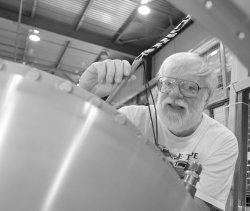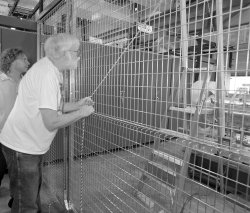 |
|
Just the Right Type by Mike Perricone
“A D-Type sold at auction recently for just under $2 million,” Bugel said. “There were about 80 built for competition. They won the LeMans [24-hour] race three times in a row in the late 1950s. That’s the one I’ll have if I ever win a lottery. Of course I don’t actually buy lottery tickets. The lottery is a tax on those who are bad at math.”
For now, he’s satisfied with the D-Type image on his website, to go with photos of three other vintage British sports cars he has at home in Vermont: a 1951 MG-TD, a 1959 MGA (he’s driven that one to Fermilab) and a 1969 E-Type Jaguar that’s almost refurbished.
The MiniBooNE experiment is another project nearing completion, with the anticipation of recording its first data in 2002. That’s where a fourth neutrino might signal its appearance. The compact, short-baseline neutrino experiment, based at Fermilab’s 8-GeV Booster accelerator (hence the name), aims at confirming or refuting the evidence for neutrino oscillations claimed by the Liquid Scintillating Neutrino Detector (LSND) experiment at Los Alamos National Laboratory.
“I really want to see this result one way or the other,” Bugel said. “The Los Alamos signal is very intriguing, and it almost requires that there be a fourth neutrino of some sort if it’s confirmed. So we all want to know one way or the other. And if there’s that much physics beyond the Standard Model, that would be pretty exciting.”
“The bottom line is that he’s incredibly valuable,” said MiniBooNE co-spokesperson Janet Conrad. “He might not match a postdoc’s level of sophistication with data analysis. But he’s REALLY sophisticated in building things and solving problems, and in handling the everyday tasks of what an experimental physicist actually does. He thinks like a physicist. And he’s a mechanical engineer, which is an extremely handy skill to have on an experiment.”
Bugel’s most recent project involves calculating the stresses on thousands of photomultiplier tubes during the upcoming task of filling the MiniBooNE detector tank with 250,000 gallons of oil. The tank will be filled later in the year, and at lower temperatures, than originally planned. But the greatest concern has grown from the shattering loss of thousands of photomultiplier tubes when fluid was replaced in Japan’s Super-K neutrino detector on November 12.
Bugel’s calculations compared the pressure in the shockwave, should a tube at the bottom of the MiniBooNE tank implode, to the shockwave pressure in Super-K where the tubes survived within a few meters of the surface.
Bugel’s verdict: MiniBooNE is in the clear.
“In our most conservative model, we’ve got a safety factor of about two,” he concluded. “Our tubes are rated to withstand a higher pressure than theirs, so I really don’t think we have a problem.”
“They wanted 300 measurements,” Bugel recalled. “But each time, you would have to turn off the power supply and go into the cage to move the probe. That takes 15 minutes. Multiply 300 measurements by 15 minutes, and you’ve got a big chunk of time. I thought there had to be some simple way of indexing the probe without going into the cage.”
What Bugel came up with was a little spring-loaded ball in a collar, with machined detents in the probe placed at one-centimeter intervals, and a plastic rope tied to the end and fed out through the cage. The procedure: take a measurement, pull the rope so the probe moves to the next click, measure, pull to the next click, and so on. Bugel took his design to technician Andy Lathrop and together they made the modification.
“This way,” Bugel said, “you can get 30 measure-ments without having to go into the cage. And then, you only have to go in there 10 times to mount the probe in a different hole. I spent a couple of days doing that, but it saved the experiment a couple of weeks of time.”
For that improvement, MiniBooNE can thank the legacy of a father who tinkered, out of interest and necessity, as Bugel grew up in the Hudson Valley mill town of Philmont in upstate New York, where his 86-year-old mother still lives.
“My dad had a 10th-grade education but he was very clever,” Bugel recalled. “We never had any money, but any time something broke he took it apart and figured out how it worked, and he fixed it. That’s what he did, and that’s what I learned to do.”
Early in his career as a mechanical engineer, Bugel answered a job ad for a physics teacher at a small private school in Vermont, thinking it would be fun to do for a little while. He’s now been there almost 30 years. Stratton Mountain School has 100 students in grades nine through 12—all serious snow athletes.
“The school grew up around a ski racing program,” he said. “When I say they’re serious, I’m talking about 20-odd alumni who have been Olympic skiers or World Cup competitors. It’s a pretty high-powered program. I often hear other teachers bemoaning money spent on athletics, but I deal with kids who are really serious about athletics and I see it as a great motivator. Every kid who’s there wants to be there. He may not want to study physics, but he knows he has to do it to stay there—and he finds there’s lots of physics in skiing.”
Bugel, who built his own house in Vermont (“I installed a photovoltaic system and the house uses no commercial electrical power,” he says), teaches conceptual physics to ninth-graders and standard physics to 12th-graders at Stratton Mountain, emulating the Leon Lederman model of beginning the high school science cycle with physics. He was recently cited for his outstanding classroom efforts by the Network of Educators in Science and Technology in Boston, which grew from a summer workshop at MIT for middle school and high school teachers (“It used to be New England Science Teachers, but we outgrew New England, and we wanted to add technology and keep NEST as the acronym,” he chuckled). He enlivens his senior class with modern physics topics—relativity, quantum mechanics, cosmic ray measurements—adapted from his Fermilab work.
The lab connection began in the fall of 1993, when Bugel applied to a Department of Energy program called TRAC, a summer research program for high school teachers at national laboratories (TRAC is still running at Fermilab, though no longer as a DOE-wide program). Bugel’s application caught the eye of Janet Conrad at Fermilab’s NuTeV experiment, and she arranged an eight-week position at NuTeV for the summer of 1994. Bugel built the experiment trigger with a Columbia University grad student, then worked on a cosmic ray data analysis project that turned into a publication on using the NuTeV calorimeter to characterize high-energy cosmic ray muons.
Bugel enjoyed the summer experience so much, he wanted to spend a sabbatical year at Fermilab. He’d been at Stratton Mountain for almost 20 years at the time, and thought he was due for some time off. The school supported him, and so did the lab. Kevin McFarland, a postdoc Bugel had met at NuTeV, suggested to the lab’s Directorate that a year-long fellowship for high school teachers was a worthwhile idea. The Directorate agreed, and Bugel returned a year later on the first Fermilab Teacher Fellowship. (Another high school teacher, Robert Sparks of Bradenton, Florida is currently spending a year working on the Sloan Digital Sky Survey.)
“As an educational institution, Fermilab is the most wonderful educational environment I’ve ever experienced, including universities,” Bugel said. “I suppose if you wanted to come here and NOT learn anything, you probably could, but you’d have to work at it.”
Still, there might come a summer when he’s drawn to a place other than the lab.
“Somebody in the Canary Islands saw my Web page with the D-Type as my dream car,” Bugel said. “He emailed me that he owned one, and if I ever got to the Canary Islands I should look him up and we could take it for a drive. That’s almost enough to make me want to buy a ticket to the Canary Islands.”
|
| last modified 12/14/2001 email Fermilab |
FRLsDFx9eyfrPXgV
 An ideal future designed by Len Bugel would include a fourth type of neutrino and a D-Type Jaguar.
And while a fourth neutrino remains speculative, Bugel might be closer to spotting the particle than he is to owning the car.
An ideal future designed by Len Bugel would include a fourth type of neutrino and a D-Type Jaguar.
And while a fourth neutrino remains speculative, Bugel might be closer to spotting the particle than he is to owning the car.
 It would also be a gratifying presentation as a modern topic in physics for his high school students back in Vermont, when he returns to the Stratton Mountain School from this second sabbatical year at Fermilab. While Bugel fits easily into the MiniBooNE collaboration as a sort of “long-term part-timer,” being a high-school teacher makes him a rarity in the working field of high-energy physics. His niche in the collaboration might normally be filled by a postdoctoral researcher, but his contribution (including his background as a mechanical engineer) adds value that can’t be measured by degrees.
It would also be a gratifying presentation as a modern topic in physics for his high school students back in Vermont, when he returns to the Stratton Mountain School from this second sabbatical year at Fermilab. While Bugel fits easily into the MiniBooNE collaboration as a sort of “long-term part-timer,” being a high-school teacher makes him a rarity in the working field of high-energy physics. His niche in the collaboration might normally be filled by a postdoctoral researcher, but his contribution (including his background as a mechanical engineer) adds value that can’t be measured by degrees.
 When he arrived at the lab this past summer, Bugel found a project that seemed to be waiting for his hands-on creativity. The collaboration wanted to plan a series of measurements of the magnetic field inside the experiment’s horn, which focuses and directs the particle beam for neutrino production. Efforts had produced a probe that could be mounted to cooling ports on the outside of the horn and inserted into the internal electromagnetic field.
When he arrived at the lab this past summer, Bugel found a project that seemed to be waiting for his hands-on creativity. The collaboration wanted to plan a series of measurements of the magnetic field inside the experiment’s horn, which focuses and directs the particle beam for neutrino production. Efforts had produced a probe that could be mounted to cooling ports on the outside of the horn and inserted into the internal electromagnetic field.